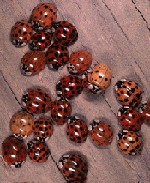 Let’s start with the Asian ladybugs. Right now they are
alternating between resting and sunning, weather-dependent of
course. These are the beetles that overwintered as adults and
are looking for a place to stay and something to eat. We’ve
already had a round or two this spring, and we’re sure to have
more with the type of weather we’ve experienced. Sunrooms,
porches and windows are the obvious collection points for the
beetles. Let’s start with the Asian ladybugs. Right now they are
alternating between resting and sunning, weather-dependent of
course. These are the beetles that overwintered as adults and
are looking for a place to stay and something to eat. We’ve
already had a round or two this spring, and we’re sure to have
more with the type of weather we’ve experienced. Sunrooms,
porches and windows are the obvious collection points for the
beetles.The best control in the home is a vacuum cleaner. If
you have numbers too large for that control, area sprays of an
aerosol flying insect killer will knock down the ones it hits.
If you are terribly bothered, try a perimeter spray of the
foundation, door areas and window areas on the home with a
pesticide that will last for a while. Color test the material on
siding first, and hope for the best. The pesticides are
effective, but they are sometimes overwhelmed by the number of
ladybugs that you are trying to control. Permethrin and
bifenthrin are probably the most commonly used pesticides for
perimeter sprays.

 A common home invader over the past several weeks has been
the millipede. Millipedes are hard-shelled animals that are
wormlike with many segments. They also curl up when disturbed.
Most body segments have two pairs of legs, except for the three
behind the head. Adults are 1-2 inches long and can be brown,
tan or gray. Most millipedes are scavengers. They feed on
decaying organic matter such as leaves, compost and grass
clippings. They may sometimes injure small, young plants by
feeding on the roots and tender plant parts, but this is rather
rare. A common home invader over the past several weeks has been
the millipede. Millipedes are hard-shelled animals that are
wormlike with many segments. They also curl up when disturbed.
Most body segments have two pairs of legs, except for the three
behind the head. Adults are 1-2 inches long and can be brown,
tan or gray. Most millipedes are scavengers. They feed on
decaying organic matter such as leaves, compost and grass
clippings. They may sometimes injure small, young plants by
feeding on the roots and tender plant parts, but this is rather
rare.
When they enter the home in large numbers, they can become
quite a nuisance. They do not bite, feed on clothing or cause
any real damage. They are simply a nuisance. Control of
millipedes in the house is best accomplished by running the
vacuum cleaner.
[to top of second column] |

Most insecticides are not very effective against millipedes. The
best way to prevent them from entering the home is to remove and
discard accumulations of leaves, rocks, boards and other trash from
around the foundation of the house. Also, keep shrubbery and flower
beds free of leaf mulch during the warm months. Foundation sprays of
permethrin or bifenthrin may have some effectiveness, but they may
not provide satisfactory control. To apply these sprays, spray the
foundation of the house and the adjacent foot of soil. In severe
cases, you may need to expand the soil treatment area (and maybe
spray the entire yard).
Also with some warmer weather come the swarms of insects that
raise that perennial question of "Are they ants or termites?"
Swarming time for both insects is about the same time, and they are
really looking to start new colonies because they have outgrown
their old ones. This is the reason for the winged insects: The wings
allow the ants or termites to cover larger areas to start their new
colonies.
The differences between ants and termites are several. Let's
start with the body color. Termites are always blackish in color,
while ants may be black or other colors. If you have winged insects
that are not black, you don't have termites. Next, look at the body
shape. Ants have a constricted "waist," while termites don't have
that classic hourglass figure. Antennae and wings are the other two
body parts to look at. Antennae on ants are elbowed, basically in an
"L" shape, and those on termites are straight. Both ants and
termites have pairs of wings, but termite wings on the same side
will be of equal length, while ant wings are of different lengths on
the same side.
[By
JOHN FULTON,
University of Illinois Extension, Logan County] |